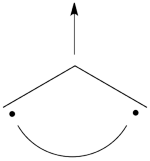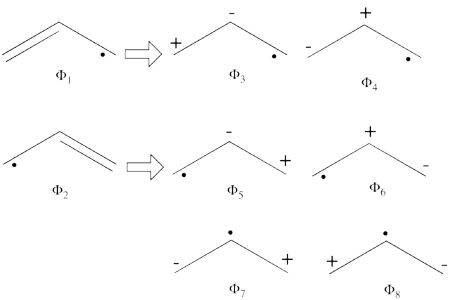Différences entre les versions de « VBTutorial2 »
Aller à la navigation
Aller à la recherche
| Ligne 10 : | Ligne 10 : | ||
{| class="collapsible collapsed wikitable" | {| class="collapsible collapsed wikitable" | ||
|- | |- | ||
| − | !<big>'''Main exercises'''</big> | + | !<big><big>'''Main exercises'''</big></big> |
|- | |- | ||
| | | | ||
| Ligne 18 : | Ligne 18 : | ||
{| class="collapsible collapsed wikitable" | {| class="collapsible collapsed wikitable" | ||
|- | |- | ||
| − | !'''Paper exercise''' | + | !<big>'''Paper exercise'''</big> |
|- | |- | ||
| | | | ||
| Ligne 33 : | Ligne 33 : | ||
# Covalent and ionic structures of the allyl radical : | # Covalent and ionic structures of the allyl radical : | ||
## What are the possible ionic structures for the allyl radical ? Based on your chemical knowledge, propose a selection subset of the most chemically meaningful covalent + ionic structures. | ## What are the possible ionic structures for the allyl radical ? Based on your chemical knowledge, propose a selection subset of the most chemically meaningful covalent + ionic structures. | ||
| + | |||
| + | {| class="collapsible collapsed wikitable" | ||
| + | |- | ||
| + | !'''Answer'''</big> | ||
| + | |- | ||
| + | | | ||
| + | ====''1. Covalent structures of the allyl radical:'' ==== | ||
| + | #The following are the three possible covalent structures:<br/>[[File:Allyl_CovStruct1.png|450px]] <br/> According to the thumb rules of qualitative VB theory (given in lecture I), both <math> \Phi_1 </math> and <math> \Phi_2 </math> display an unpaired electron in the vicinity of one end of a covalent bond. The energy for this repulsion is <math> -\beta</math>S, while the energy of the covalent bond is <math> 2\beta</math>S. Therefore, the total energy for either <math> \Phi_1 </math> or <math> \Phi_2 </math> is <math> \beta</math>S. For <math> \Phi_3 </math>, the unpaired electron is in the vicinity of both ends of the covalent bond, therefore the corresponding repulsion is twice <math> -\beta</math>S. As for the energy of the covalent bond, it can be neglected since it is a "long" bond, between atoms that are not neighbors. So the total energy for <math> \Phi_3 </math> is <math> -2\beta</math>S. | ||
| + | #<math> | ||
| + | \Phi_{\textrm{1}} = \vert a\bar{b}c\vert - \vert \bar{a}bc\vert | ||
| + | |||
| + | </math> <br> <math> | ||
| + | \Phi_2 = \vert ab\bar{c}\vert - \vert a\bar{b}c\vert | ||
| + | |||
| + | </math> <br> <math> | ||
| + | \Phi_3 = \vert ab\bar{c}\vert - \vert \bar{a}bc\vert = \Phi_1 + \Phi_2 | ||
| + | |||
| + | </math><br> | ||
| + | <br>Since <math> \Phi_{\textrm{3}} </math> is the positive combination of <math> \Phi_{\textrm{1}} </math> and <math> \Phi_{\textrm{2}} </math> the two first structures form a complete basis of non-redundant structures. | ||
| + | <br> | ||
| + | <br> | ||
| + | |||
| + | ====2.''Understanding the pattern of spin density distributions in the allyl radical as found in EPR spectroscopy''==== | ||
| + | # The wave functions of the non-redundant structures are <br>[[File:Allyl_Spin-Dist.png|350px]]<br> <br> <math> | ||
| + | |||
| + | \Phi_L = \frac{1}{\sqrt2}[\vert a\bar{b}c\vert - \vert \bar{a}bc\vert] | ||
| + | </math><br> <math> | ||
| + | |||
| + | \Phi_R = \frac{1}{\sqrt2}[\vert ab\bar{c}\vert - \vert a\bar{b}c\vert] | ||
| + | |||
| + | </math> <br> <br> The negative combination of these two wave functions determines the ground state wave-function of allyl radical <br> <math> | ||
| + | \Phi_{GS}= \Phi_L - \Phi_R= \frac{1}{\sqrt6}[2\vert a\bar{b}c\vert - \vert \bar{a}bc\vert - | ||
| + | \vert ab\bar{c}\vert] | ||
| + | |||
| + | </math> <br> <br> We note with that respect that the determinant with the largest coefficient in the ground state is the spin-alternant determinant. We can see that the weight of this spin-alternant determinant is four times larger than the corresponding weights of the two other determinants. This, as we will show later can explain the polarization of the spin density. <br> <br> Now, let's use the following expression for the spin density: <math> | ||
| + | \rho_k= N^2 \sum_i {c_i}^2 {\delta_{ki}} | ||
| + | |||
| + | </math> to calculate the spin density distribution in the allyl radical: <br> <math> | ||
| + | |||
| + | \rho_a = \frac{1}{6}[4 - 1 + 1] = \frac{2}{3} | ||
| + | |||
| + | </math><br> <math> | ||
| + | \rho_b = \frac{1}{6}[-4 + 1 + 1] = -\frac{1}{3} | ||
| + | |||
| + | </math><br> <math> | ||
| + | \rho_c = \frac{1}{6}[4 + 1 - 1] = \frac{2}{3} | ||
| + | |||
| + | </math> <br> <br> | ||
| + | # Since <math> \Phi_{GS} </math> is dominated by the spin-alternant determinant <math> \vert a\bar{b}c\vert </math>, (as mentioned before, it has the largest coefficient in the ground state), the spin distribution properties could in fact be predicted without any calculation, but just by looking at the spin-alternant determinant. | ||
| + | ## Here is a pictorial representation of the spin-alternant determinant. It is clear that it predicts spin polarization with a spin-down on the central carbon atom and spin-up on the two terminals. As such, (since it dominates the ground state wave-function) it is predicted that the ground state wave function will exhibit the same spin distribution. In other words, in principle, in this case it could be sufficient to look at this spin-alternant determinant to get a qualitative correct estimate of the spin distribution. <br> <br>[[File:arrowsSpin-Dist.png|150px]]<br><br> | ||
| + | ## The spin-alternant determinant will generally dominate the wave function of the ground state for the entire series of conjugated radicals. For example, if we wish to predict/understand the spin density patterns of the pentadienyl radical, all we have to do is draw the spin-alternant determinant. Thus, as shown below for pentadienyl the central carbon atom has spin up, and the spins alternate in direction on both sides. <br> <br>[[File:5arrowsSpin-Dist.png|250px]] <br> <br> The next radical in line (with 7 carbons) will have a similar spin distribution as in allyl, with spin-down in the center flanked by spin-ups on both sides, etc.<br> <br> | ||
| + | ## Lets turn now to the excited state of allyl radical. Since the ground state is the negative combination of the <math> \Phi_L </math> and <math> \Phi_R </math> structures above, the excited state is the corresponding positive combination. This positive combination eliminates the spin-alternant determinant, and we remain with: <math> | ||
| + | \Phi_{EXS} = \Phi_L + \Phi_R= \frac{1}{\sqrt2}[\vert ab\bar{c}\vert -\vert \bar{a}bc\vert ] | ||
| + | </math><br> <br> Pictorially, this is simply the cyclopropyl structure with spin density localized only on the central carbon: <br>[[File:arrowsSpin-Dist-EXC1.png|150px]]<br> <br> Note how the spin switches from the ground- to the excited state. It is generally true that in the first excited state of the polyenyl radicals, the spin alternant determinant vanishes and the spin density is determined by the long bond structures. | ||
| + | <br> | ||
| + | |||
| + | ====3. ''Covalent and ionic structures of the allyl radical:'' ==== | ||
| + | #From each covalent structure we can get two ionic structures. Additional two ionic structures are obtained from the redundant structure. Therefore overall there are 6 different ionic structures <br>[[File:Allyl_Ionic-N1.png|450px]] <br> In the two ionic structures (<math> \Phi_{\textrm{7}} </math>,<math> \Phi_{\textrm{8}} </math>) that are based on the redundant structure the charges are farther from each otehr compared with the other ionic structures and are thereofre, expected to be higher in energy. These two structures will therefore not be included in our chosen sub-set of structures. | ||
| + | |||
| + | |} | ||
| + | |||
|} | |} | ||
| Ligne 38 : | Ligne 99 : | ||
{| class="collapsible collapsed wikitable" | {| class="collapsible collapsed wikitable" | ||
|- | |- | ||
| − | !'''Computer Exercise''' | + | !<big>'''Computer Exercise'''</big> |
|- | |- | ||
| | | | ||
| Ligne 93 : | Ligne 154 : | ||
{| class="collapsible collapsed wikitable" | {| class="collapsible collapsed wikitable" | ||
|- | |- | ||
| − | !<big>'''Optional Exercises - Homework'''</big> | + | !<big><big>'''Optional Exercises - Homework'''</big> |
|- | |- | ||
| | | | ||
Version du 12 juillet 2012 à 09:29
VB applications on PI systems
In all the following exercises, <math>\pi</math> the system will be taken as active, and the <math>\sigma</math> system as inactive. In all VB calculations, the <math>\sigma</math> orbitals shall be described by MOs delocalized onto the whole molecule.
| Main exercises | ||||
|---|---|---|---|---|
Exercise 1 : The allyl radical
Exercise 2 : Radical character of ozoneComputer Exercises
\psi_{H\ddot{u}ckel} = 25%\Phi_1 +
25%\Phi_2 + 12.5%\Phi_3 +
25%\Phi_4 + 6.25%\Phi_5 +
6.25%\Phi_6
</math> Paper Exercises - Optional/Homework
|
| Optional Exercises - Homework | ||
|---|---|---|
Exercise 3 : Resonance energy of BenzeneComputer Exercise
Exercise 4 : The allyl cation
Computer Exercise
|





